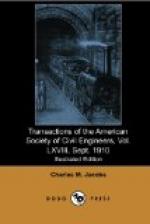The Bay Ridge Improvement of the Long Island Railroad comprises the readjustment of the right of way and the establishment of new grades in order to do away with grade crossings from the freight terminal at Bay Ridge to a junction with the New York Connecting Railroad at East New York, a distance of 10.4 miles. It also provides for the re-location of the line and the elimination of grade crossings on the branch running to Manhattan Beach, a distance of 3.7 miles. The work is being executed without interrupting traffic, and in all about 75 grade crossings will be abolished. This improvement became necessary in order to provide for the rapid extension of population into the suburban districts and for the present and future requirements of the section, to establish municipal conveniences and facilities, and to open additional streets across the right of way. To accomplish these ends, the line has been built in cuts and on embankments, there being about 6.4 miles of the former, 3.3 miles of the latter, and a tunnel, 3,500 ft. long, where the line crosses the Atlantic Avenue improvement.
The Atlantic Avenue improvement, as mentioned above, involved the removal of the railroad tracks from the street surface for a distance of about 5-1/4 miles. This was done by constructing a series of elevated and subway structures, there being about 2.1 miles of the former, 2.4 miles of the latter, and 0.8 mile of approaches, eliminating more than 90 grade crossings. In the light of recent developments, it may be of interest to note that one of the reasons for establishing a combination elevated and subway line was that, at the time the improvement was projected, no underground railroad in the country, of similar length and carrying a heavy volume of local traffic, was operated by electricity, and public sentiment was against the operation of the entire length of the line underground by steam power. This improvement also provided for depressing the entire Flatbush Avenue station and a freight yard. As the work progressed, the original plans for the station were greatly enlarged, the remodeled station covering about 61 city lots.
The main point of passenger distribution is the New York station. Other important stations will be Flatbush Avenue, Brooklyn; Jamaica, Long Island, where the changes to and from electric motive power will be made; and Newark, N. J. Many other places, including the seaside resorts on Long Island and in New Jersey, will feel the benefits of the direct tunnel railroad into and through New York City. The Glendale Cut-Off will materially shorten the route and running time from New York through the tunnels to Rockaway Beach.




